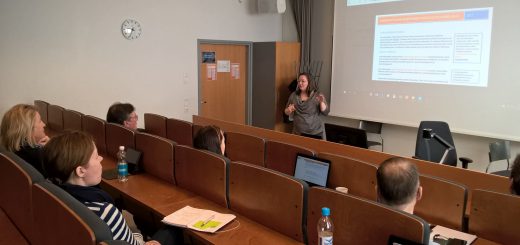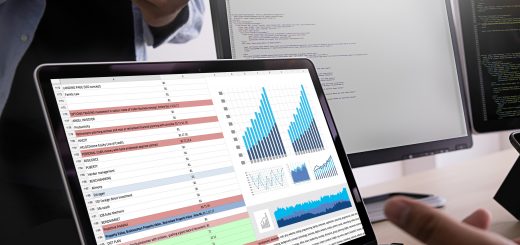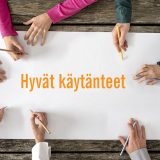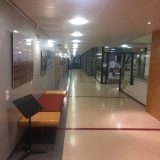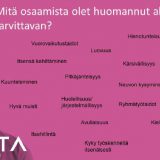Case of co-development under COVID-19 restrictions
Regulations to contain the spread of COVID-19 have led to forced digitalization and increased use of web-conferencing systems. Careful planning of online sessions is a requirement of productive interaction. This is particularly important when the aim of the meeting is co-development and collaboration. Web conferencing systems have become a mainstream communication channel and combining them with other on-line tools offer a practicable alternative to physical interaction.

PHOTO 1: Jagrit Parajuli/Pixabay.com
Co-development invites us all
It is fair to say that co-operation penetrates today’s working life. Virtually no planning, development or decision-making is done entirely independently. Instead, we are part of various teams and projects, where our roles and responsibilities differ. These joint ventures exist within an organisation and between organisations (private, public, voluntary sector). In the course of time co-operation has been an interest of several fields, like community planning [1] and forest management planning [2]. Participatory planning or collaborative planning have been the key terms.
In Finland, interaction and communication were brought into authoritative planning processes in Land Use and Building Act in 1999 [3]. The definition of participants and the obligation of participation were written down in the law. In the end all co-operation comes down to participation. Who are the ones who take part and how do we support their engagement? In this blog a co-development case is depicted, from the preparation phase to the actual implementation. A particular participatory method called Future workshop was utilised. The blog underlines careful preparation when facilitating workshops especially online. Yet a bold recommendation to employ online approaches for co-development is given.
Future workshop
An online workshop was organised in November 2020 under multinational project Sustainable Resilient Coast (COAST) [4]. The project stresses grassroot approach, collaboration with local authorities and their stakeholders. Initially, it was planned that the event would have been arranged face-to-face. It would have served the very idea of the method Future workshop.
Future workshop is an approach to be considered when there is a local issue or challenge of a particular development to be dealt with. Workshops are usually targeted at those who are either affected by the issue and its development or are professionally linked to the case. In the workshop aims are defined and problems identified. Future workshop has three sequential phases: critical analysis phase, visionary phase, and implementation phase. Choices and assessments are made during the process. Participants, who usually work in small groups, write down their thoughts to shared whiteboards. In this way thinking is made visible as the workshop proceeds. [5]
Total length of Future workshop varies. It can be from a few hours to several days [5]. When organising it online and as a “one-night stand” 3–4 hours is the maximum length.
Online co-development calls for rigorous groundwork
Due to COVID-19-mitigation efforts the plan to arrange a face-to-face meeting was soon changed to online implementation. This brought about various new things to consider. No event can be converted virtual just like that. All potential variables had to be taken into consideration. In a face-to-face event these sudden turns are easier to handle as part of the play. Usually, experienced organisers have thought of a plan B to cope with everything that takes place unexpectedly. In an online implementation to response efficiently and effectively is another story. For instance, the minimum requirement for a successful online meeting is that no one gets lost during the gathering or at least finds his/her way back when strayed.
Firstly, the most risk-free and suitable applications for the gathering were tested. The main aim of the workshop was that its realization had to be as simple as possible. Regardless of available online tools, all interested parties should be able to attend. Web-conferencing system Zoom [6] was chosen. It is easy to use and allows breakout rooms. It is a very important feature when organising online group work. For instance, MS Teams did not have it back then. The available Zoom version also offers good data security.
After careful thought Padlet [7, see photo 2] was chosen for online collaboration. It is simple to use and allows value assessment in many ways (thumbs up/down, hearts, stars 1–5, grades). Also commenting is possible. All this can be done anonymously, which is sometimes a crucial condition for active participation.

PHOTO 2. Padlet homepage
After deciding on the applications, a rigours script was written, and the applications were tested. Two intensive meetings were held, on which the script was revised and the features of Padlet were checked. In the end an agenda with nine items and the script with 29 notes was accepted. The notes consisted of all the items that were necessary to remember during the gathering, like “Going to Breakout Rooms”, “If many critical views appear, study them together” or “Reformulation of views that are difficult to understand”.
Hybrid co-development is here to stay
The online future workshop was not a success if we assess it against the carefully written script and the number of participants. Since the turnout was less than expected no breakout rooms were needed, which again, affected the whole realization of the workshop. Also, some of the nice features of Padlet were lost during the workshop. For instance, there is a possibility to hide and open commenting areas, which is sometimes an important element. This feature did not work and thus had to be ignored.
Then again, the workshop was a success for various reasons. First, all three phases were pulled through. The participants were active, and discussion was vivid. As they say, it is not the quantity but the quality that counts. The workshop resulted in several critical views (phase 1), positive suggestions (phase 2), and concrete actions (phase 3).
Year 2020 made us search new ways to encounter and it led to a new virtual togetherness. The COVID-19 pandemic taught us how to keep safe distance and yet remain in contact with our colleagues, partners, students, and stakeholders, for instance [8]. One could claim that there is no turning back. The working life will not be the same as it was before the pandemic. Instead, online meetings, webinars and workshops will become the new normal. Also, it is expected that various new hybrid operation models and new applications will turn up for the benefit of co-development and collaboration.
Virkkula Outi, Oulun ammattikorkeakoulu
lehtori, luonnonvara-ala
Maunumäki Arja, Oulun ammattikorkeakoulu
lehtori, luonnonvara-ala
O’Rourke Merja, Oulun ammattikorkeakoulu
lehtori, luonnonvara-ala
Tervo Kati, Oulun ammattikorkeakoulu
projektisuunnittelija, luonnonvara-ala
Sources
[1] Healey, P. 1997. Collaborative planning: Shaping places in fragmented societies. Basingstoke: Macmillan.
[2] Kangas, A., Kangas, J. & Kurttila, M. 2008. Decision support for forest management. New York: Springer.
[3] Land Use and Building Act 132/1999. Retrieved 3.2.2021. https://www.finlex.fi/fi/laki/kaannokset/1999/en19990895.pdf
[4] Sustainable Resilient Coasts. Retrieved 26.1.2021. https://coast.interreg-npa.eu/
[5] Future workshop. Action catalogue. Retrieved 26.1.2021. http://actioncatalogue.eu/method/7391
[6] Zoom solutions. Retrieved 26.1.2021. https://zoom.us/
[7] Padlet. Make something beautiful. Retrieved 26.1.2021. https://padlet.com/
[8] Hacker, J., vom Brocke, J., Handali, J., Otto, M. & Schneider, J. 2020. Virtually in this together – how web-conferencing systems enabled a new virtual togetherness during the COVID-19 crisis. European Journal of Information Systems 29 (5), 563–584. Retrieved 8.2.2021. https://doi.org/10.1080/0960085X.2020.1814680

Pysyvä osoite: http://urn.fi/urn:nbn:fi-fe202102255943


